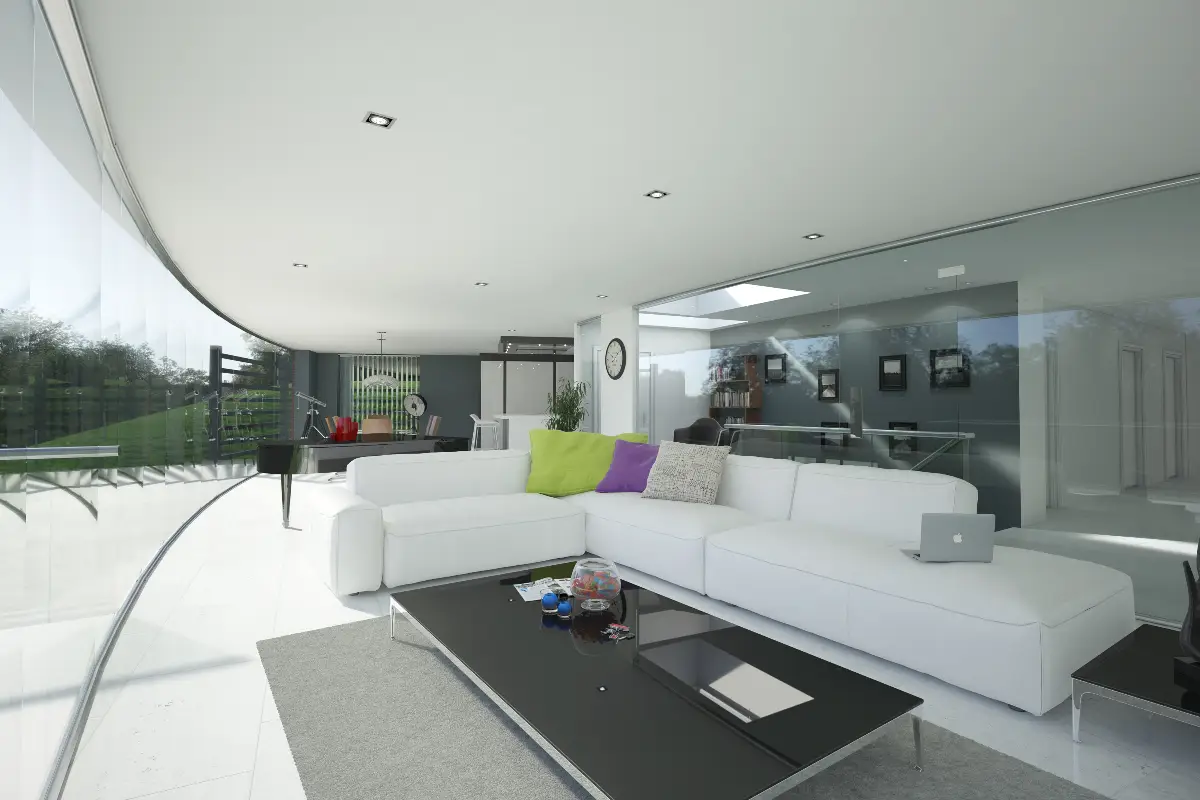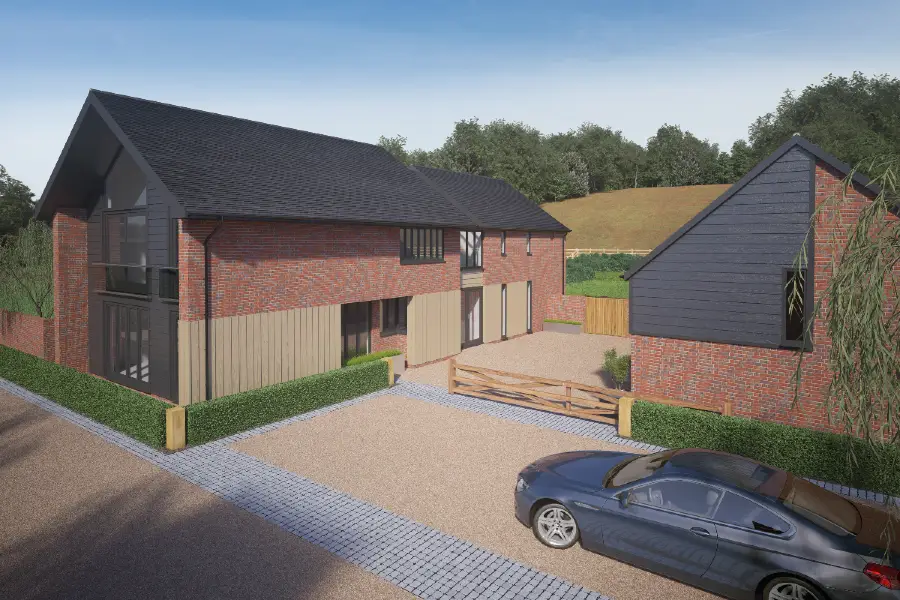Canterbury New Build: Two-Storey Penthouse Above Modern Flats
New build flats with rooftop penthouse
We helped our client - a local building contractor and developer - transform a post-war house located in a Canterbury Conservation Area into an ambitious project: a striking new block of flats crowned by a large penthouse, replacing the original property.
To fulfil his accommodation brief, we designed an asymmetric landmark building featuring dynamic material changes and shadow lines.
Completed in 2018, the project includes a spacious four-bedroom, two-storey penthouse, a hidden balcony with views of Canterbury Cathedral, and traditional elements such as red brick, jettying, stone banding, and Juliet balconies.
Alexandra House, A Contemporary New Build with Traditional Detailing In A Canterbury Conservation Area
Alexandra House stands at 43 Queen’s Avenue, the first street you encounter when entering Canterbury via the ring road from Faversham and the A2. This prominent location, facing an open green, marks a key arrival point into the city.
Both Queen’s Avenue and the adjacent London Road lie within a designated Conservation Area characterised by robust red brickwork, clay tile roofs, stone detailing, and white box-frame sash joinery.
Choosing Taylor Roberts To Design A New Build In Canterbury
Our client first encountered our work while reviewing planning applications on the local authority’s portal.
He was particularly impressed by our design for an adjacent new-build scheme on London Road, which successfully balanced complementary architectural form and massing with the character of the surrounding Conservation Area.
Keen to achieve a similarly thoughtful, high-quality outcome, he approached us to design his property redevelopment on Queen’s Avenue.
The Brief
The client’s brief was straightforward: to create a block of flats topped by a substantial two-storey penthouse.
He gave us the freedom to develop a design that would maximise the building’s potential and respond sensitively to its Conservation Area setting.
Because 43 Queen’s Avenue sits at the top of the Conservation Area, we saw an opportunity to create a landmark building. Corner plots are particularly valuable architecturally, offering double frontage and historically acting as key markers in the urban landscape. Their significance is often emphasised through greater height and distinctive massing.
This design freedom allowed us to create a four-storey building, rather than the typical three-storey structures found along London Road.
The Design
From the outset, we set out to design a building that responded to its context without falling into pastiche. We avoided simply replicating nearby corner buildings and deliberately rejected modern rainscreen cladding style architecture - large, monolithic structures lacking empathy with the local character.
Instead, by incorporating jettying and staggered gables, we shifted the building’s mass as it rises, creating changes in materials and shadow lines that bring real depth and visual interest.
At the same time, we were careful to respect the lower height and massing of the neighbouring property on Queen’s Avenue, setting the bulk of the building back from the gable end at the corner to minimise its impact.
The projecting jetties allowed us to achieve a larger footprint, adding accommodation value while maintaining architectural balance.
The design further accentuates an asymmetric form, using complementary materials and strongly emphasising detailing. We carefully added features such as timberwork in the gables, stone banding, and a stone doorcase to enhance the building’s character. We also incorporated Juliet balconies, which, although not traditional Victorian elements, overlook the open green, creating a pleasant, open aspect.
The Two-Storey Penthouse With Private Lift
The penthouse is a substantial four-bedroom flat, offering generous living space.
In today’s market, particularly in Canterbury, it’s rare to see flats of this size being built. Today, most new developments offer two-bedroom units.
The penthouse has a private lift, which offers the owner direct access to their home and enhances the sense of exclusivity and luxury.
The Materials
The materials palette is strongly inspired by Victorian architecture.
Terracotta ridge tiles and finials crown the roof, while clay plain tiles cover the main slopes. Areas of tile hanging, with scalloped tiles arranged in horizontal bands, add richness and detail, recalling the Victorian love for Italianate and Gothic influences.
Traditional red stock brickwork laid in Flemish bond strengthens the historic feel, while reconstituted stone banding, based on Bath stone, adds another layer of authenticity.
White timber box sash windows, timber bargeboards, black iron railings, and cast iron rainwater goods bring more texture and depth to the building.
White gable pendants and detailed cornice work complete the look, celebrating the intricacy and craftsmanship that defined the Victorian era.
The Planning Application Approval Process
After delivering the feasibility study and viability assessment, we developed the initial sketch proposals and agreed to the client's brief.
We then engaged with the Local Planning Authority through the pre-application process to help secure a smooth approval.
During the pre-app meetings, the planning officer raised concerns about the massing at the gable end on the corner, particularly its potential impact on light levels and the sense of overbearing on the neighbouring property on Queen’s Avenue.
In response, we reduced the building’s mass at the corner before submitting the full application. Thanks to these early negotiations and design adaptations, the planning process progressed smoothly within the standard eight-week determination period.
The Client’s Feedback
The building continues to serve its owner well. He still lives in the penthouse with his family and enjoys its bright, open interior and hidden balcony. He has often spoken to us about how much he enjoys living there.
Some of the best feedback came from the owner’s friends, who praised the building’s quality and design after completion.
If you are planning a Canterbury new build, Taylor Roberts can support you with bespoke architectural services.
We offer everything from feasibility studies, CAD drawings, and visualisations to housing developments, commercial construction projects, and design and build contracts. We work in Canterbury and throughout the South-East.
Call us on 01227 457 545 or email us on enquiries@taylorroberts.co.uk to chat about your project.
Contact our team today for expert property advice - book now for free.


.webp)
.webp)
.webp)
.webp)

